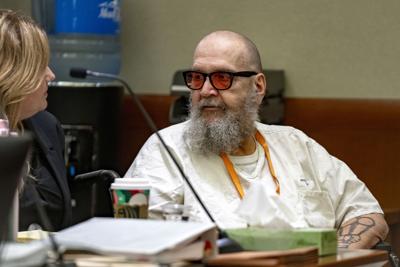SALT LAKE CITY (AP) — A Utah judge on Wednesday set an execution date for a man with dementia who has been on death row for 37 years, even as his lawyers file appeals and argue his condition is worsening.
Ralph Leroy Menzies, 67, is set to be executed Sept. 5 for abducting and killing Utah mother of three Maurine Hunsaker in 1986. When given a choice decades ago, Menzies selected a firing squad as his method of execution. He would become only the sixth U.S. prisoner executed by firing squad since 1977.
Judge Matthew Bates signed the death warrant a month after he ruled Menzies “consistently and rationally” understands why he is facing execution despite recent cognitive decline. Attorneys for Menzies have petitioned the court for a reassessment, but Bates said Wednesday that the pending appeal was not a basis to stop him from setting a date.
Bates did, however, schedule a July 23 hearing to evaluate the new competency petition. Menzies' attorneys say his dementia has gotten so severe that he uses a wheelchair, is dependent on oxygen and cannot understand his legal case.
“We remain hopeful that the courts or the clemency board will recognize the profound inhumanity of executing a man who is experiencing steep cognitive decline and significant memory loss,” said Lindsey Layer, an attorney for Menzies. “Taking the life of someone with a terminal illness who is no longer a threat to anyone and whose mind and identity have been overtaken by dementia serves neither justice nor human decency.”
The Utah Attorney General’s Office has “full confidence” in the judge's decision, Assistant Attorney General Daniel Boyer said.
The U.S. Supreme Court has at times spared prisoners with dementia from execution, including an Alabama man in 2019 who had killed a police officer. If a defendant cannot understand why they are being put to death, the high court said, then an execution is not carrying out the retribution that society is seeking.
For Hunsaker's son Matt, who was 10 years old when his mother was killed, it has been “hard to swallow that it’s taken this long” to get justice.
“You issue the warrant today, you start a process for our family,” he told the judge Wednesday. “It puts everybody on the clock. We’ve now introduced another generation of my mom, and we still don’t have justice served.”
Hunsaker, 26, was abducted by Menzies from a convenience store where she worked in the Salt Lake City suburb of Kearns. She was later found strangled and her throat cut about 16 miles (25 kilometers) away at a picnic area in Big Cottonwood Canyon. Menzies had Hunsaker’s wallet and several other belongings when he was jailed on unrelated matters. He was convicted of first-degree murder and other crimes in 1988.
Over nearly four decades, attorneys for Menzies filed multiple appeals that delayed his death sentence, which had been scheduled at least twice before it was pushed back. He and other Utah death row inmates sentenced before May 2004 were given a choice between firing squad and lethal injection. For inmates sentenced in the state after that date, lethal injection is the default method unless the drugs are unavailable.
Utah last executed prisoners by firing squad in 2010, and South Carolina used the method on two men this year. Only three other states — Idaho, Mississippi and Oklahoma — allow firing squad executions.
Menzies is among 10 people scheduled to be put to death in seven states during the remainder of 2025. Twenty-five men in the U.S. have died by court-ordered execution so far this year.



